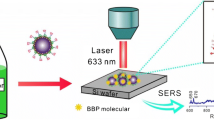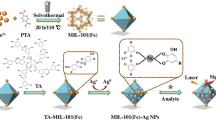Abstract
Phenformin hydrochloride (PHE), once used as a traditional anti-diabetic drug, has now been banned due to significant side effects. However, the phenomenon of the illegal addition of PHE to hypoglycemic healthcare products is still rampant. Thus, the detection of illegally added PHE is urgently needed. Surface-enhanced Raman scattering (SERS) is a promising candidate for this purpose, but the weak affinity between PHE and bare metal (Au or Ag) limits direct SERS detection of PHE. In this paper, we prepared Ag nanoparticles coated with β-cyclodextrin (AgNP@β-CD), which display the coffee-ring effect, that can be used for PHE sensing. β-CD-functionalized nanoparticles could capture the analyte and fix the molecular orientation in the hydrophobic cavity. The coffee-ring effect could improve the SERS effect through a higher concentration of the analyte, higher density of nanoparticles, and more hot spots. The SERS performance of the AgNP@β-CD substrate was characterized by using o-phenylenediamine dihydrochloride as a probe molecule. The excitation wavelength and pH value were optimized. A linear response for PHE detection is in the 7.0 × 10−8–1.0 × 10−6 mol L−1 concentration range, and the limit of detection is as low as 8.0 × 10−9 mol L−1. This AgNP@β-CD coffee-ring effect substrate was applied to the detection of PHE in healthcare products, with recoveries between 95.3 and 105.0% and relative standard deviations of less than 5.16%. It is anticipated that the AgNP@β-CD substrate will also have great potential for the monitoring of other aromatic drugs in healthcare products.







Similar content being viewed by others
References
Si KJ, Guo P, Shi Q, Cheng W. Self-assembled nanocube-based plasmene nanosheets as soft surface-enhanced raman scattering substrates toward direct quantitative drug identification on surfaces. Anal Chem. 2015;87(10):5263–9.
Lai EPC, Feng SY. Molecularly imprinted solid phase extraction for rapid screening of metformin. Microchem J. 2003;75(3):159–68.
Chen Y, Zhao L, Lu F, Yu Y, Chai Y, Wu Y. Determination of synthetic drugs used to adulterate botanical dietary supplements using QTRAP LC-MS/MS. Food Addit Contam. 2009;26(5):595–603.
Pang W, Yang H, Wu Z, Huang M, Hu J. LC-MS–MS in MRM mode for detection and structural identification of synthetic hypoglycemic drugs added illegally to ‘natural’ anti-diabetic herbal products. Chromatographia. 2009;70(9):1353–9.
Cui M, Li N, Qin F, Li F, Xiong Z. Simultaneous determination of 14 illegal adulterants in Chinese proprietary medicines using reversed-phase ion-pair LC. Chromatographia. 2010;72(11):1189–94.
Fang F, Qi Y, Lu F, Yang L. Highly sensitive on-site detection of drugs adulterated in botanical dietary supplements using thin layer chromatography combined with dynamic surface enhanced Raman spectroscopy. Talanta. 2016;146:351–7.
Liu Z, Jia F, Wang W, Wang C, Liu Y. Determination of phenformin hydrochloride using molecular imprinting technology coupled with flow-injection chemiluminescence. Lumin J Biol Chem Lumin. 2012;27(4):297–301.
Shi L, Xie J-H, Du L-M, Y-x C, Wu H. Determination of phenformin hydrochloride employing a sensitive fluorescent probe. Spectrochim Acta Part A. 2016;162:98–104.
Lin JH, Lin YT, huang YJ. Isolation and cytotoxicity of flavonoids from Daphnis genkwae flos. J Food Drug Anal. 2001;9(1):6–11.
Boeglin A, Fort A, Mager L, Combellas C, Thiébault A, Rodriguez V. Geometrical structure and nonlinear optical response of a zwitterionic push–pull biphenyl compound. Chem Phys. 2002;282(3):353–60.
Patze S, Huebner U, Liebold F, Weber K, Cialla-May D, Popp J. SERS as an analytical tool in environmental science: the detection of sulfamethoxazole in the nanomolar range by applying a microfluidic cartridge setup. Anal Chim Acta. 2017;949:1–7.
Yunker PJ, Still T, Lohr MA, Yodh AG. Suppression of the coffee-ring effect by shape-dependent capillary interactions. Nature. 2011;476:308.
Yueksel S, Schwenke AM, Soliveri G, Ardizzone S, Weber K, Cialla-May D. Trace detection of tetrahydrocannabinol (THC) with a SERS-based capillary platform prepared by the in situ microwave synthesis of AgNPs. Anal Chim Acta. 2016;939:93–100.
Wang W, Yin Y, Tan Z, Liu J. Coffee-ring effect-based simultaneous SERS substrate fabrication and analyte enrichment for trace analysis. Nanoscale. 2014;6(16):9588–93.
Sun C, Chen T, Ruan W, Zhao B, Cong Q. Controlling the orientation of probe molecules on surface-enhanced Raman scattering substrates: a novel strategy to improve sensitivity. Anal Chim Acta. 2017;994:65–72.
Zhang Y, Huang X, Liu W, Cheng Z, Chen C, Yin L. Analysis of drugs illegally added into Chinese traditional patent medicine using surface-enhanced Raman scattering. Anal Sci. 2013;29(10):985–90.
Shi Y, Liu W, Chen C. Two-step centrifugation method for subpicomolar surface-enhanced Raman scattering detection. Anal Chem. 2016;88(9):5009–15.
Yang K-H, Liu Y-C, Yu C-C. Simple strategy to improve surface-enhanced Raman scattering based on electrochemically prepared roughened silver substrates. Langmuir. 2010;26(13):11512–7.
Xie Y, Wang X, Han X, Xue X, Ji W, Qi Z. Sensing of polycyclic aromatic hydrocarbons with cyclodextrin inclusion complexes on silver nanoparticles by surface-enhanced Raman scattering. Analyst. 2010;135(6):1389–94.
Loftsson T, Brewster ME. Pharmaceutical applications of cyclodextrins. 1. Drug solubilization and stabilization. J Pharm Sci. 1996;85(10):1017–25.
Loftsson T, Magnúsdóttir A, Másson M, Sigurjónsdóttir JF. Self-association and cyclodextrin solubilization of drugs. J Pharm Sci. 2002;91(11):2307–16.
Stiles PL, Dieringer JA, Shah NC, Duyne RPV. Surface-enhanced Raman spectroscopy. Annu Rev Anal Chem. 2008;1(1):601–26.
Halvorson RA, Vikesland PJ. Drop coating deposition Raman (DCDR) for microcystin-LR identification and quantitation. Environ Sci Technol. 2011;45(13):5644–51.
Han W, Lin Z. Learning from “coffee-rings”: ordered structures enabled by controlled evaporative self-assembly. Angew Chem Int Ed. 2012;51(7):1534–46.
Zhu Q, Yu X, Wu Z, Lu F, Yuan Y. Antipsychotic drug poisoning monitoring of clozapine in urine by using coffee-ring effect based surface-enhanced Raman spectroscopy. Anal Chim Acta. 2018;1014:64–1070.
Andrade PF, de Faria AF, da Silva DS, Bonacin JA, Gonçalves MC. Structural and morphological investigations of β-cyclodextrin-coated silver nanoparticles. Colloids Surf B. 2014;118:289–97.
Lee PC, Meisel D. Adsorption and surface-enhanced Raman of dyes on silver and gold sols. J Phys Chem. 1982;86:3391.
Egyed O. Spectroscopic studies on β-cyclodextrin. Vib Spectrosc. 1990;1(2):225–7.
Schneider H-J, Hacket F, Rüdiger V, Ikeda H. NMR studies of cyclodextrins and cyclodextrin complexes. Chem Rev. 1998;98(5):1755–86.
Qiu B, Hu J, Yin L, Zhang Y. Study of phenformin hydrochloride by surface-enhanced Raman scattering. Chin Pharm. 2013;16(4):552–5.
Pan X, Dong J, Li Y, Sun X, Yuan C, Qian W. The strategy of two-scale interface enrichment for constructing ultrasensitive SERS substrates based on the coffee-ring effect of AgNP@β-CD. RSC Adv. 2016;6(35):29586–91.
Kim DJ, Jeon TY, Park S-G, Han HJ, Im SH, Kim D-H. Uniform microgels containing agglomerates of silver nanocubes for molecular size-selectivity and high SERS activity. Small. 2017;13(23):1604048.
Premkumar R, Premkumar S, Rekha TN, Parameswari A, Mathavan T, Benial AMF. Surface Enhanced Raman Spectroscopic Studies on Aspirin : An Experimental and Theoretical Approach. AIP Conference Proceedings, 2016; https://doi.org/10.1063/1.4946664
Funding
This work was financially supported by the Science-Technology Development Project of Jilin Province of China (No.20170101174JC) and the National Natural Science Foundation (Grants 21,327,803, 21,773,080, 21,711,540,292) of the People’s Republic of China.
Author information
Authors and Affiliations
Corresponding author
Ethics declarations
Conflict of interest
The authors declare that they have no conflict of interest.
Electronic supplementary material
ESM 1
(PDF 756 kb)
Rights and permissions
About this article
Cite this article
Zhang, L., Li, P., Bu, X. et al. Combined host-guest complex with coffee-ring effect for constructing ultrasensitive SERS substrate for phenformin hydrochloride detection in healthcare products. Anal Bioanal Chem 410, 7599–7609 (2018). https://doi.org/10.1007/s00216-018-1399-6
Received:
Revised:
Accepted:
Published:
Issue Date:
DOI: https://doi.org/10.1007/s00216-018-1399-6




